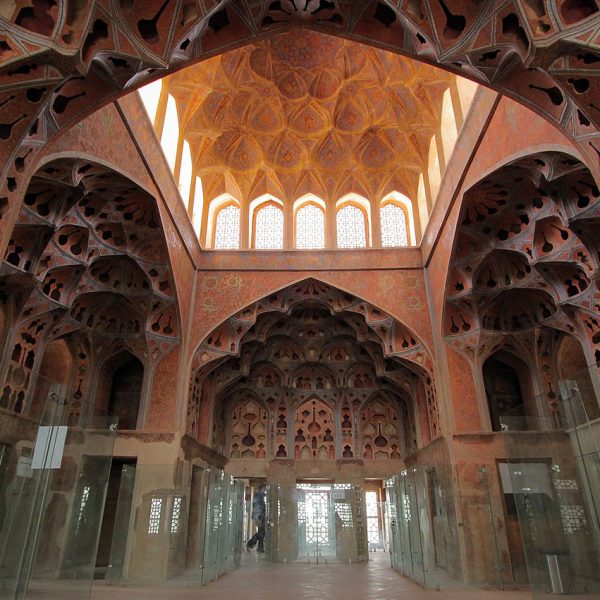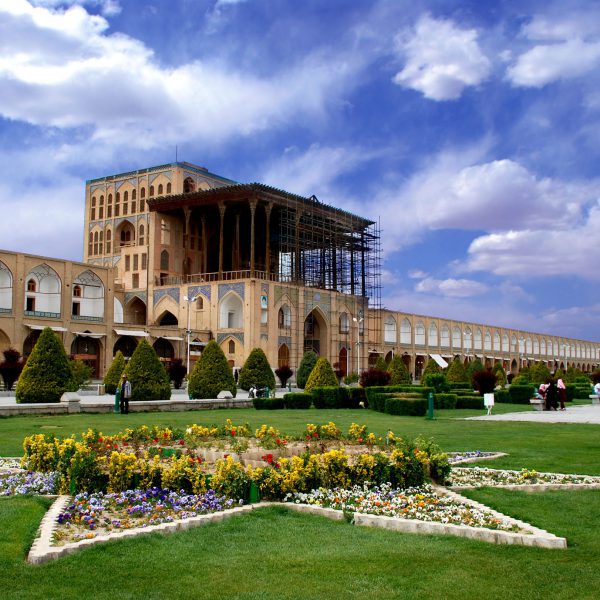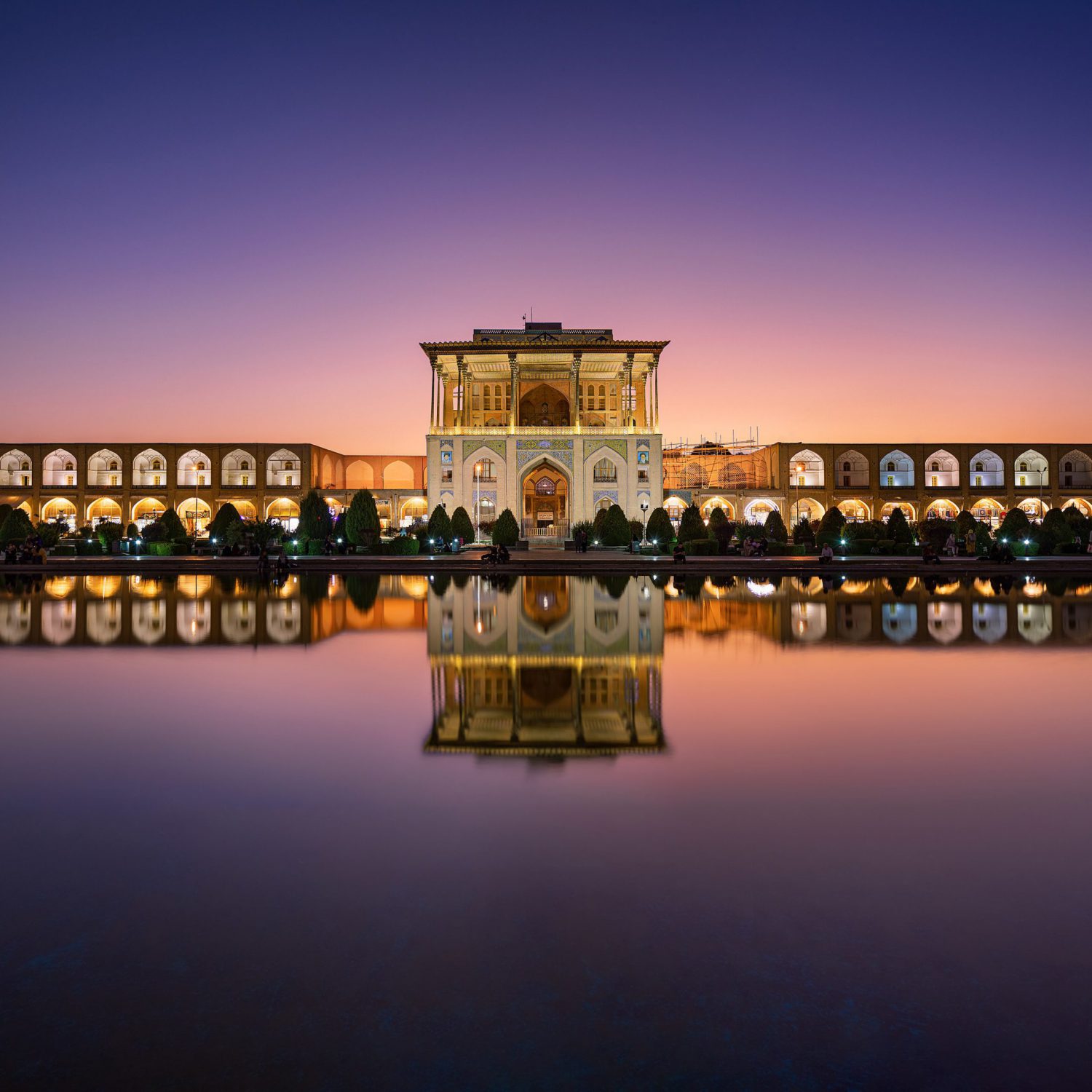Ali Qapu is an imperial Palace on the western side of the UNESCO recognized Naqsh-e Jahan Square. This Palace is a collection of architectural highlights and splendor of Safavid Dynasty with 400 years of antiquity. As one of the four corners of an important square, this imperial palace is a symbol of power. It has 5 floors with 48 meters of height within an area of 1500 square meters. Also, there is a half floor on top of the building which is famous for its delicate plasterwork. Accordingly, this half floor is the Music Hall which features an acoustic environment. The Balcony of this grand Palace, overlooking the great Naqsh-e Jahan Square, is another distinctive part of it. In this post, we will be talking about the significance, facts, and history, and points of interest of this palace.
The Significance of Ali Qapu’s Name
Master Ali Akbar Isfahani took orders from Shah Abbas of Safavid to build a palace. According to some sources, at that time, Shah Abbas was in rivalry with the Ottoman Empire. Interestingly, there was a building called Ali Qapo, built in Turkey. That is why Shah Abbas wanted a palace that would be greater that the Ottoman Palaces. Notably, the name Ali Qapu translates as ‘the Greatest Gate’. Though, some say that the word ‘Ali’ refers to the first Shia Imam, Ali.
Why did the new capital need a Royal Palace?
Overall, this palace was to become the center of government, when Shah Abbas chose Isfahan as his new capital. From the time of Shah Abbas to the last Safavid King, Shah Sultan Hussein, Ali Qapu was an imperial palace. This means that the kings of Safavid and their courtiers choose this palace for their meetings and official receptions. Also, the kings hosted many foreign ambassadors in this palace.
Other Functions of Ali Qapu Palace
During the reign of the second Shah Abbas, a balcony with 18 high columns was added to the palace. Plus, a marble pond with fountains in the middle of the Balcony, created a pleasant atmosphere there. From then, Ali Qapu became a palace for the leisure of the kings and their families. Accordingly, from the balcony of the place they could have watched the games and ceremonies, held in Naqsh-e Jahan Square. Also, according to some sources, the palace was an entrance to the Harem of the kings. The significance of Ali Qapu palace becomes clearer according to its historical importance. With that, let us get into the history and facts behind Ali Qapu Palace. However, the unique decorations of the palace adds to its splendor which we will later be talking about.
Ali Qapu Palace’s Facts & History
The city of Isfahan and Naqsh-e Jahan Square became the center of Safavid government around 400 years ago. In the place of Naqsh-e Jahan there used to be a complex of gardens by the same name. According to some sources, back then, there was a Timurid Palace in the middle of these gardens. Shah Abbas, the king of Safavid, ordered the construction of a new palace. Accordingly, Master Ali Akbar Isfahani build a new palace by reforming the previous palace. Actually, at that time, the palace was only a two-story building. Today, we can see a five-story palace with a balcony and a Music Hall. This is a result of several additions through the years. Accordingly, these additions were carried out during the reign of Shah Abbas II, Shah Suleiman, and Shah Sultan Hussein.

Points & Architectural highlights of Ali Qapu Palace
What makes Ali Qapu unique, is actually its architectural highlights. Ali Qapu was once the tallest building in Iran. There are plenty of points in this palace which make it a masterpiece of architecture. As we mentioned earlier, this palace was the work of several additions during the years. Interestingly, that is why from each side of the building you can have a different view of the palace. Accordingly, from the front view, it seems that the palace has only two floors with a balcony. However, from the sides, you can see a three-story palace. If you have a look at the building from the behind, you can see all five floors of it. The sixth floor which is the Music Hall is not visible from the outside. Now, let us get into the details of this masterpiece of architecture.
What to Expect Before Entering Ali Qapu Palace
- There are about 114 steps to the top of the palace. These steps are each 22 centimeters high and have beautiful tilework on them. These steps, called the ‘Shahi’ Steps, were for the use of the king, his courtiers, and guests.
- A spiral staircase with 94 steps leading to the Music Hall in the last floor.
- Plasterworks in different colors and shapes
- Tong Bori Plasterwork (making delicate shapes of vases and other utensils with plaster on the walls and ceilings).
- Muqarnas Plasterwork.
- Different wall paintings and Murals of hunting grounds, floral and stucco patterns, and other Persian and Islamic patterns.
- Tempera and European paintings.
- Layechini (layer work) and delicate gold decorations.
- Decorations on the ceilings.
Walking Through Ali Qapu Palace
From the Naqsh-e Jahan Square, the great gate of Ali Qapu Palace stands out. Actually, as the symbol of power, this palace despite other buildings in the square, was built a few meters further. The doors of the gate to the palace are actually from the holy Shrine of Imam Ali in Najaf. Accordingly, Shah Abbas ordered the construction of a golden gate as a replacement for these doors in Najaf.
Beyond the Great Gate of the Palace
After passing through the gate, you will reach a hallway. This hallway is famous for its echo function under its dome at its corners. Accordingly, if you whisper something in one corner, a person on the apposed corner can hear you. After passing through this hallway, you can enter the palace. Here, by taking the tile covered steps, you can reach the first and second floors. These floors were the waiting rooms where the king’s guests would have waited for approval for meeting the king.
The Balcony of the Royal Palace
After taking 45 more steps, you will reach the balcony of the palace. This is where the amazing view of Naqsh-e Jahan Square will carry you away. There are 18 columns which hold this balcony. Actually, each of these columns is a plane tree. There is a pond in the middle of the balcony. Notably, 400 years ago, having a pond with fountains on the second floor was itself a masterful invention. Behind the balcony, there is a great hall with fantastic paintings and decorations. This hall is accessible through a wooden window which is actually a door. It was the main place for holding ceremonies and the meetings of the king.
The Music Room and Hall
From the third floor, through a spiral staircase, you can reach the Music Room. This room is one of the greatest rooms of the palace. This is where you can find a special type of Persian Art called Tong Bori. This type of plasterwork covers the Music Room and Hall. This room for its acoustic feature was where music was played and practiced.

When and where can I visit Ali Qapu Palace?
Ali Qapu Palace is open every day except for Islamic Holidays and Fridays, during the time of Prayer. The opening hours of this Palace are:
- From 9 AM to 4:30 PM.
As for arriving at Ali Qapu Palace, you first have to reach Naqsh-e Jahan Square. The best way to get to Naqsh-e Jahan Square is by getting on the subway. You can get off at Imam Hossein Station and walk to the Square. On its western side, right in front of Sheikh Lotfollah Mosque, you will find the grand entrance of the palace.
Attractions near Ali Qapu Palace
If you are interested in visiting another palace belonging to the Safavids, you can visit its nearby Chehel Sotun Palace. This Palace, in the heart of a Persian Garden, is a famous UNESCO Site. Also, you can explore Naqsh-e Jahan Square. Plus, the Qeysarieh Bazaar, Sheikh Lotfollah Mosque, and Shah Mosque are right in the square next to this palace.
Other Famous Historic Attractions near Ali Qapu Are:
- Hasht Behesht Palace
- Chahar Bagh Street
- Sio-se-Pol and Khaju Bridges
Also, you can visit the traditional Bazaars around the Palace for getting a piece of the local life. However, aside from the historical attractions, Isfahan has much to offer. Before leaving Isfahan, make sure you try its local Food & Signature Dishes. For more information, you can check out our blog’s post about Isfahan, its points of interest & things to do.


Comment (0)